MXA RACE TEST: THE REAL TEST OF THE 2019 KTM 450SXF

Q: FIRST AND FOREMOST, IS THE 2019 KTM 450SXF BETTER THAN THE 2018 450SXF?
A: Yes. It should be noted that it is easier for a 2019 Honda, Yamaha, Suzuki or Kawasaki to be better than their 2018 offerings, because they have lots of room to improve. KTM can’t brag about all the new stuff that the “Big Four” can, because mods that are new to the green, blue, red and yellow brands have been on KTMs for years. The Big Four can add electric starting, while KTMs have had push-button starting for 20 years. The Big Four can update their bikes with hydraulic clutches, as Kawasaki did in 2019, but KTM has had hydraulic clutches all along. The Big Four can tout stronger brakes as a major improvement, but they still aren’t as good as KTM’s Brembo units. The Big Four can switch to finger-follower valve trains, as Honda and Kawasaki have done, but KTM got there years ago.
So, when asked if the 2019 KTM 450SXF is better than the 2018 450SXF, you have to understand that KTM is at a disadvantage. KTM can’t shoot ducks in the water like the Big Four; it has to shoot them on the fly. Yes, the 2019 KTM 450SXF is better than the 2018 KTM 450SXF, but not in a buzz-worthy way (and maybe not for everybody).
Q: HAVEN’T WE SEEN THIS BIKE BEFORE?
A: You bet. Back in December of 2017, KTM announced that it would release 400 units of the 2018-1/2 KTM 450SXF Factory Edition to interested buyers at a premium price. Essentially, KTM was selling the 2019 bike to a select group of racers months in advance of releasing the actual 2019 model.
How does the KTM Factory Edition differ from Honda’s new 2019 CRF450 Works Edition? The biggest difference is that KTM was selling a limited run of next year’s bike a half year before it went on sale as a 2019 production bike. Honda is selling a kitted CRF450 at the same release date as the production CRF450 at a $2200 premium. The Honda CRF450 Works Edition is essentially a copy of a rich guy’s 2019 CRF450 project bike—with slip-on mufflers, Ken Roczen graphics, polished head, a new ECU map, and fancy coatings on the forks and shock.
The 2019 KTM 450SXF offers the same frame geometry as in 2018, but with more torsional rigidity, a longer swingarm and narrower chassis.Q: HOW DOES THE 2019 KTM 450SXF DIFFER FROM THE 2018 KTM 450SXF?
A: There are a lot of subtle differences between the 2019 and 2018 bikes, but they are mostly slight technical mods that do their best work out of the limelight. Here is a quick—but by no means complete—list of mods.
(1) Stiffer frame. The 2019 frame is 10 percent stiffer torsionally and only slightly stiffer longitudinally. The increase in torsional stiffness, which comes from the redesigned head tube gusseting and a larger cross brace, reduces twisting from the front end during high-load cornering, which pays dividends in overall accuracy. However, several Vet test riders preferred the softer and more flexible 2018 frame.
(2) Cylinder head. All-new models claim to have a revised cylinder head, but KTM really means it in 2019. The cylinder head is 15mm lower, which means that the cam is lower, the cam towers are stronger, valve stems are shorter and weight is reduced by over 1 pound. Lowering the camshaft, rocker arm and valves reduces the gyroscopic effects of their rotating mass while lessening cam vibration and flex at high rpm.
(3) Pankl transmission. No other motocross brand offers a transmission built by a Formula 1 gearbox supplier. The 2019 KTM four-strokes come with complete Pankl gear sets. They have the exact same gear combinations as the 2018 gearbox but with metallurgy that is a step above what was being used previously.
(4) Exhaust. The 2019 KTM 450SXF exhaust is shorter, with a larger resonance chamber and shorter muffler; but, most significantly, KTM added a slip-fit in the mid-pipe to allow the pipe to be removed without having to take the shock off the bike.
(5) Ergos. Although you can’t really see a lot of difference between the 2019 and 2018 plastic, close inspection will reveal that every piece has been massaged. The seat is flatter, gas tank lower, radiators moved down, intake tract shortened, seat foam firmed up, top triple clamp beefed up and swingarm lengthened 5mm.
Q: HOW DOES THE 2019 KTM 450SXF RUN?
A: The 2019 KTM 450SXF has a very unique style of power. It isn’t like an engine from the Big Four. It doesn’t focus on midrange hit, aggressive acceleration into the top end or a brutal low end. Instead, the 450SXF’s power is metered out in just the right proportions to maximize thrust. There are no burps, barks or bangs in the curve, just a steadily growing crescendo of power. If you are looking for one word to describe the 2019 KTM 450SXF’s power delivery, it would be “luscious.”
There is something for everyone in the KTM’s powerband. Afraid of too much bottom end? No problem, the 450SXF engine has a mellow feel off idle. Want a bike that pulls hard through the middle? No problem. The KTM’s power delivery is not linear in the sense that it doesn’t grow at a steady predictable rate across an upward line. Instead, it grows exponentially in that the power increases in large jumps that don’t follow a linear growth rate. In simple terms, the KTM 450SXF powerband gains power at a faster rate as the rpm climbs. For a slow rider, that means he can control the output with judicious throttle control. For a fast rider, that means he can ride the surging wave all the way to the rev limiter. It is the kind of powerband that can be used by everyone from Novices to AMA Pros.
A few years ago the KTM was close to cracking 60 horsepower, but since then, KTM has backed down the peak power to focus on producing a more usable and easier-to-ride style of power. The 2019 KTM 450SXF makes 57.13 horsepower, but every single horse is ready to race. There is always something left in the tank if you need it. The KTM has a very broad powerband that feels like it revs forever; however, it doesn’t rev higher than the competition—it just revs longer.
The 2019 KTM 450SXF’s greatest attribute is its light weight. At 223 pounds it is 10 pounds lighter than the lightest 450 from the Big Four and 18 pounds less than the heaviest.Q: WHAT ISSUES DID WE HAVE WITH THE 2019 KTM 450SXF ENGINE?
A: While testing the 2019 KTM 250SXF, MXA test riders immediately recognized that the power felt choked up compared to last year’s engine. This choked-up feeling reminded us of issues we’ve had in the past with the Husqvarna air boxes. The Husky’s limited air intake vents cost it throttle response. The solution for both local racers and the Rockstar Husqvarna factory riders was to drill holes in the airbox cover so it could breathe.
After our issues with the 2019 KTM 250SXF, we decided to test the 450SXF by riding it with and without the airbox cover in place. In back-to-back tests, it was obvious that the changes that the KTM engineers made to the 2019 airbox gave the orange machines the same emphysema as the Husky. Opening up the 2019 KTM 450SXF airbox produced a noticeable increase in throttle response and rate of acceleration in the midrange. In the end, we broke out our trusty drill and started opening up the airbox cover. We started by cutting the winglet off the backside of the airbox cover.

On the dyno, with the airbox opened up, the KTM 450SXF gained an average of 1-1/2 horsepower from 7500 rpm to 10,500 rpm—and peak horsepower jumped from 57.13 to 58.12 horsepower.
Q: HOW DOES THE 2019 KTM 450SXF HANDLE?
A: The MXA wrecking crew loves the neutral handling of KTM’s chromoly steel chassis. It is the best all-around-handling bike on the track. It handles instinctively thanks to the stiff front triangle. The increased head tube gusseting and doubling of the diameter of the cross-over tube resulted in a stiffer chassis. The added torsional rigidity makes the 450SXF super responsive, so much so that test riders found themselves constantly adjusting fork tube height to dial in the degree of accuracy they preferred. This is a no-fuss handler. It doesn’t require much in the way of steering input, body English or post-corner corrections to trace the perfect arc through a turn. You just have to think about choosing a line and it is there.

Q: HOW GOOD ARE THE KTM 450SXF FORKS?
A: KTM made internal changes to the 2019 WP AER air forks. There is a new two-stage base valve. The volume of the rebound (balance) air chamber has been reduced 50 percent. The compression damping has been softened, and the recommended air pressure settings are lower than in 2018. Additionally, the Neken triple clamps are 5mm wider (from front to rear), which makes them 5 percent stiffer.
As a general rule, MXA test riders like the universal appeal of the WP AER air forks. They can be set up for different track conditions, skill levels or rider weights with just a few adjustments; however, the difference between what fast riders want and what slow riders want means that the AER forks are pushed to their adjustment limit. We had no problems making Intermediate to Pro riders happy; they ran air pressures from 145 to 155 and the clickers close to stock.
Where the trouble arose was with slower riders, Vets and lightweights. Without fail, they complained about harshness at the end of the stroke, almost always confirmed by a lack of full travel on post-race inspection. In response, they ran lower air pressures, around 130 psi, with the compression clicker between 25 and 35 clicks out. Those numbers were much softer than last year, yet the test riders still whined about harshness.
Our simple solution was to use fork-leg travel, as measured by an O-ring, as a gauge of how much air pressure to run. Although we did have 130-pound test riders who went into the 128-psi range, we think that going too low could cause the forks to hang down under braking. In situations where we couldn’t get full travel out of the O-ring after lowering the air pressure, we took 10cc of fork oil out of the non-air-pressure fork leg. The lower oil height lessened mid-stroke harshness. Amazingly, some test riders removed 20cc before they found their sweet spot. You can lower the fork oil height up to the point when the forks begin to bottom, then raise it back up in 5cc increments.
Q: HOW GOOD IS THE 2019 KTM 450SXF’S SHOCK?
A: This is the best WP shock that we have ever ridden with. It doesn’t feel wallowy, nor does it want to G-out in tough situations. We set the race sag at 105mm. We went in on the high-speed compression and rebound, but, all in all, we were rightfully impressed by the shock. Still, KTM’s rear shocks are very spring-rate sensitive. The window of the available 42 N/m, 45 N/m and 48 N/m shock springs is very small. The target rider weight of the stock 45 N/m shock spring is 175 pounds. It works well for riders from 160 to 185 pounds, but riders who fall above or below the target range will need to pay close attention to static sag (free sag). It must be between 30mm and 40mm (unladened).
To measure static sag, first set your race sag to 105mm. Next, take the bike off the stand and have someone hold it vertically while you measure how much the rear suspension sags without a rider on it. If race sag is 105mm with you on the bike, it should be between 30mm and 40mm without you on board.
If your static sag is more than 40mm, your spring may be too stiff for your weight. In this case, the spring is not compressed enough to allow the suspension to extend far enough on its own. A spring that’s too firm does not allow the rear tire to hook up under acceleration and transmits more bump energy into the rider.
If the static sag is less than 30mm in the rear, the spring may be too soft for your weight. In this case, the spring requires so much preload to achieve the proper race sag that it makes the rear suspension prone to topping out under hard braking into corners and feels loose and wallowy under acceleration.
Given that lots of big boys ride KTM 450SXFs, these over 200-pounders need to pay attention to their free sag number and return to the 48 N/m spring from 2016. Lighter riders can switch to the 42 N/m spring from the 2019 KTM 250SXF.
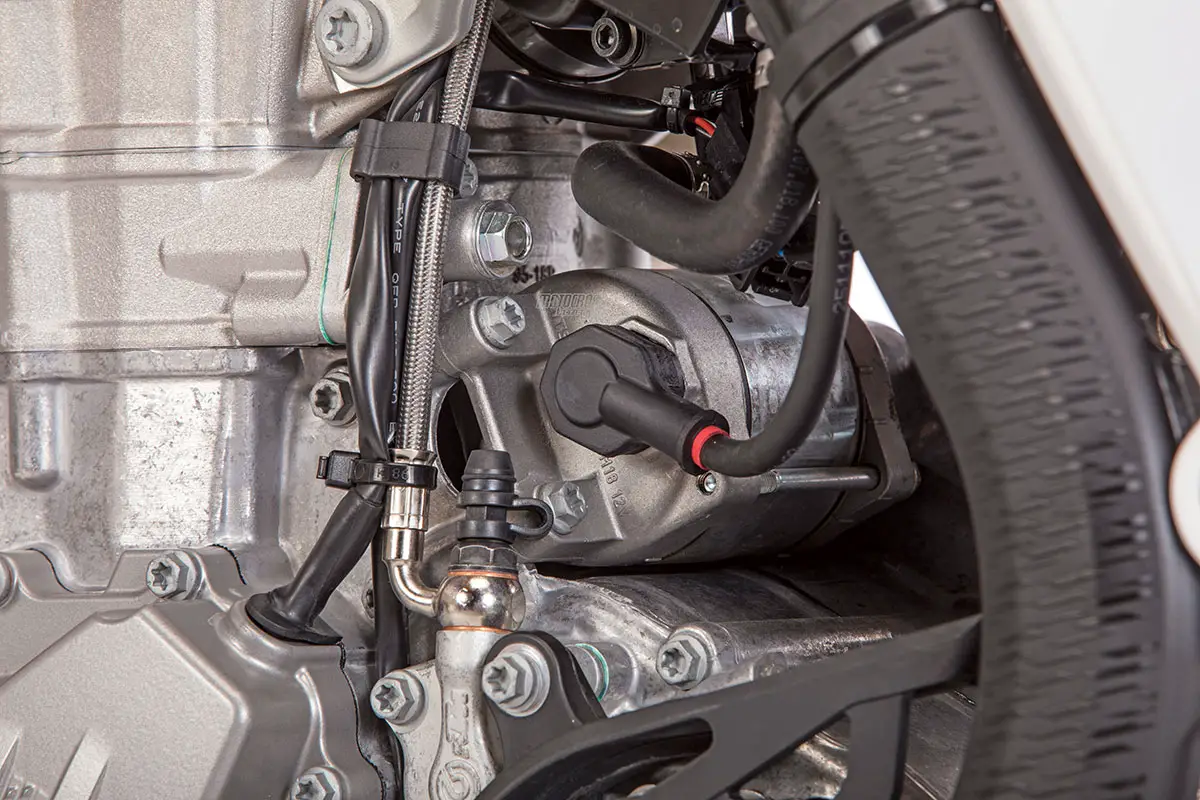
Q: WHAT DID WE HATE?
A: The hate list:
(1) Sprocket/spokes. Watch the sprocket bolts and spokes closely. They loosen up constantly.
(2) Lock-on grips. Although we like the ease of use of the ODI lock-on grips, they deliver a harsher feel to the rider’s hands because the actual rubber is half as thick as that of glue-on grips.
(3) Airbox. The 2019 KTM 250SXF, 350SXF and 450SXF have all caught a bad case of Husqvarnitis. We didn’t know it was contagious.
(4) Frame color. To quote Michael Corleone, “Just when I thought I was out, they pull me back in!” Nobody wants a black frame. KTM needs to paint it orange and leave it orange. Or, quit teasing us with orange every couple of years.

Q: WHAT DID WE LIKE?
A: The like list:
(1) Weight. Oh, the humanity! For the first time in years the KTM 450SXF actually gained weight. Last year it weighed 222 pounds. This year it weighs 223 pounds. It is still the lightest 450 on the track by as much as 19 pounds. We suspect the weight gain came from the top triple clamp, 5mm longer swingarm and overlapping plastic.
(2) Brakes. Great brakes. The best brakes.
(3) Air filter. Great Twin Air air filter.
(4) Skid plate. KTM welded mounting tabs under the frame to hold a skid plate. Nice touch.
(5) Hydraulic clutch. Kawasaki may have installed a hydraulic master cylinder on the 2019 KX450 clutch, but it is a mere shadow of KTM’s awesome clutch—from the lever to the hydraulics to the clutch basket to the clutch springs to the incredible reliability, the KTM clutch has no peer.
(6) Shifting. F1 supplier Pankl built the 2019 gear set out of higher-quality steel than the typical gearbox. Once broken in, the tranny shifts flawlessly.
(7) Radiators. The radiators are mounted 12mm lower on the frame, and the water capacity is up 20 percent.
(8) Seat bolt. The two irritating seat bolts from last year (that always refused to come out of their little nooks) have been replaced by one long seat bolt that is accessed from the left side of the frame. It is easier to use.
(9) Seat. The 2019 seat is more rounded and has firmer foam and a unique gripper seat cover.
(10) Fuel pump. Previous KTM fuel pump hoses were prone to kinking, which caused the bike to run poorly and the fuel pump to burn up. For 2019, KTM moved the fuel pump and fuel pick-up point to opposite sides of the gas tank so that the internal fuel lines would be straight across from each other.
(11) Exhaust. The new three-piece exhaust system allows the pipe to be removed without having to take the shock off first.
(12) Electronic suite. The 2019 KTM comes with two push-button maps, launch control and traction control. The new split-injection system uses two separate bursts of fuel every time the injector squirts. This results in more usable power across the midrange. The 450SXF has a secret ingredient called IG-ACC. It advances the ignition timing every time the throttle position sensor recognizes initial movement. This results in quicker throttle response.
(13) Cylinder head. The 2019 KTM cylinder head is a thing of beauty. The rotating mass was moved down by 15mm, and in the process of lowering the cams, shortening the valve stems and stiffening the cam towers, the KTM engineers produced a head design that can resist torsional vibration and the twisting forces that affect the performance of valve trains.
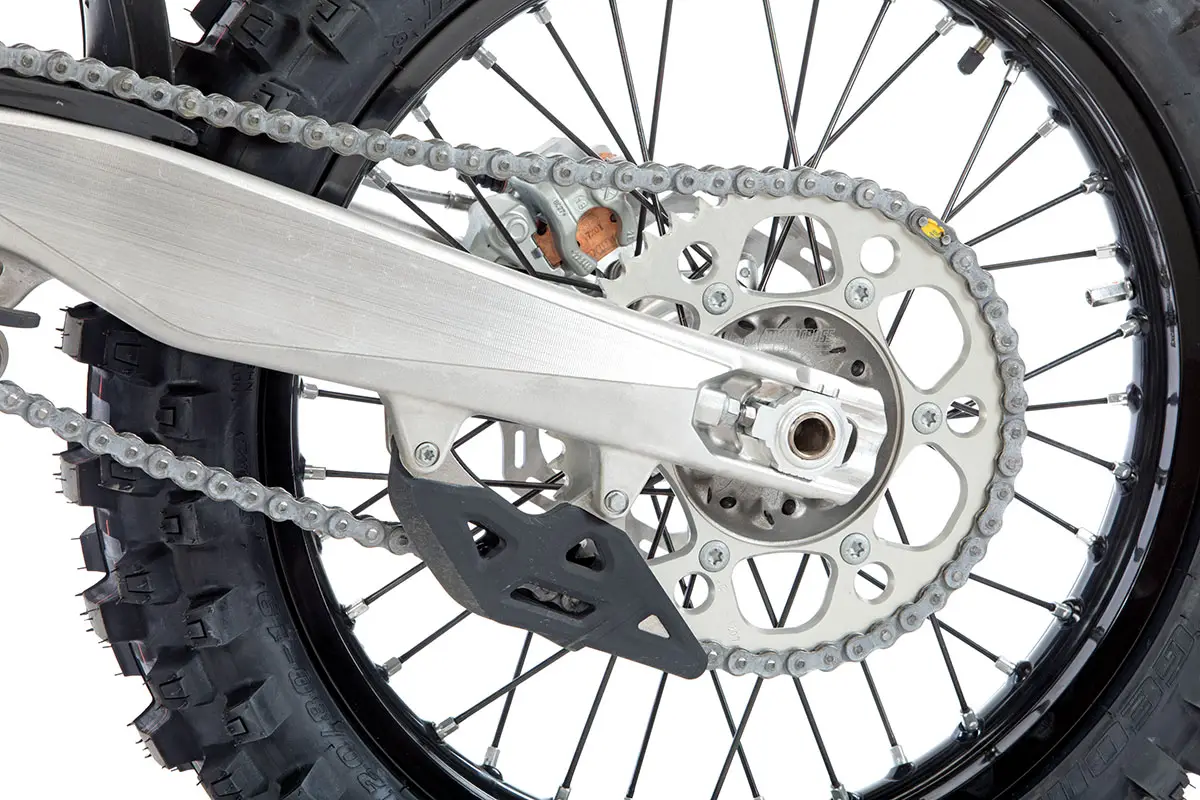
Q: WHAT DO WE REALLY THINK?
A: There is a lot to like about the 2019 KTM 450SXF (just look at the “like list”)—and that is saying something when you realize that last year’s model was the 2018 MXA 450 shootout winner. The biggest improvements from 2018 to 2019 are the more responsive, snappier and quicker initial throttle response; reduced rotational mass; thinner, flatter and narrower ergonomics; exotic Pankl gearbox; time-tested handling; strong and broad powerband and, of course, the incredible light weight.
Paradoxically, as good as the 2019 KTM is, if we owned a 2018 KTM 450SXF that was set up perfectly, we might be tempted to keep it.

MXA’S 2019 KTM 450SXF SETUP SPECS
This is how we set up our 2019 KTM 450SXF for racing. We offer it as a guide to help you find your own sweet spot.
AER FORK SETTINGS
The majority of MXA test riders ignore the recommended air pressure numbers. They are not well-suited to most KTM owners. We have had test riders of similar speeds vary their air pressure by as much as 15 pounds and both be happy with the way the forks perform. We achieved this with clicker settings. Most Vet riders tend to run lower pressures than fast riders, often as low as 130 psi. There is no harm in a low air pressure setting as long as the front of the bike doesn’t hang down in the corners and use up travel too quickly. For hardcore racing, we recommend this fork setup for an average rider on the 2019 KTM 450SXF (stock specs are in parentheses).
Spring rate: 145 psi (151 psi)
Compression: 25 clicks out (15 clicks out)
Rebound: 17 clicks out (15 clicks out)
Fork-leg height: Third line
Notes: If we feel that the forks are harsh in the middle but tend to ride high when we increase the air pressure, we lower the oil height in the damping leg by 10 to 20mm to eliminate a harsh spot in the travel. This only works for slow riders, light riders or Vet—fast riders can’t lower the oil height with having bottoming issues. Additionally, pay attention to extreme temperature changes. You may have to change the AER’s air pressure as it gets hotter later in the day. We bleed the outer chambers constantly.
WP SHOCK SETTINGS
If you are heavier than 185 pounds, you might want to run the 2016 KTM 450SXF’s 48 N/m spring. If you are lighter than 150 pounds, you should look into the 42 N/m spring from the 250SX two-stroke. Overall, this is a very good shock. Although we do make clicker adjustments, we rarely stray very far from the stock 15 clicks out on compression. It can be dialed in with only a few clicker changes. As a rule of thumb, most MXA test riders leave the low-speed compression on the stock setting and focus on the high-speed dial to make the changes. We do run additional rebound damping. For hardcore racing, we recommend this shock setup for the 2019 KTM 450SXF Factory Edition (stock specs are in parentheses):
Spring rate: 45 N/m
Race sag: 105mm
Hi-compression: 1-3/4 turns out (2 turns out)
Lo-compression: 15 clicks out
Rebound: 10 clicks out (15 clicks out)
Notes: We turned the high-speed compression damping in 1/4 turn to lessen G-outs and run more rebound than the recommended setting. Additionally, we set the sag at 105mm instead of the WP-recommended 110mm.


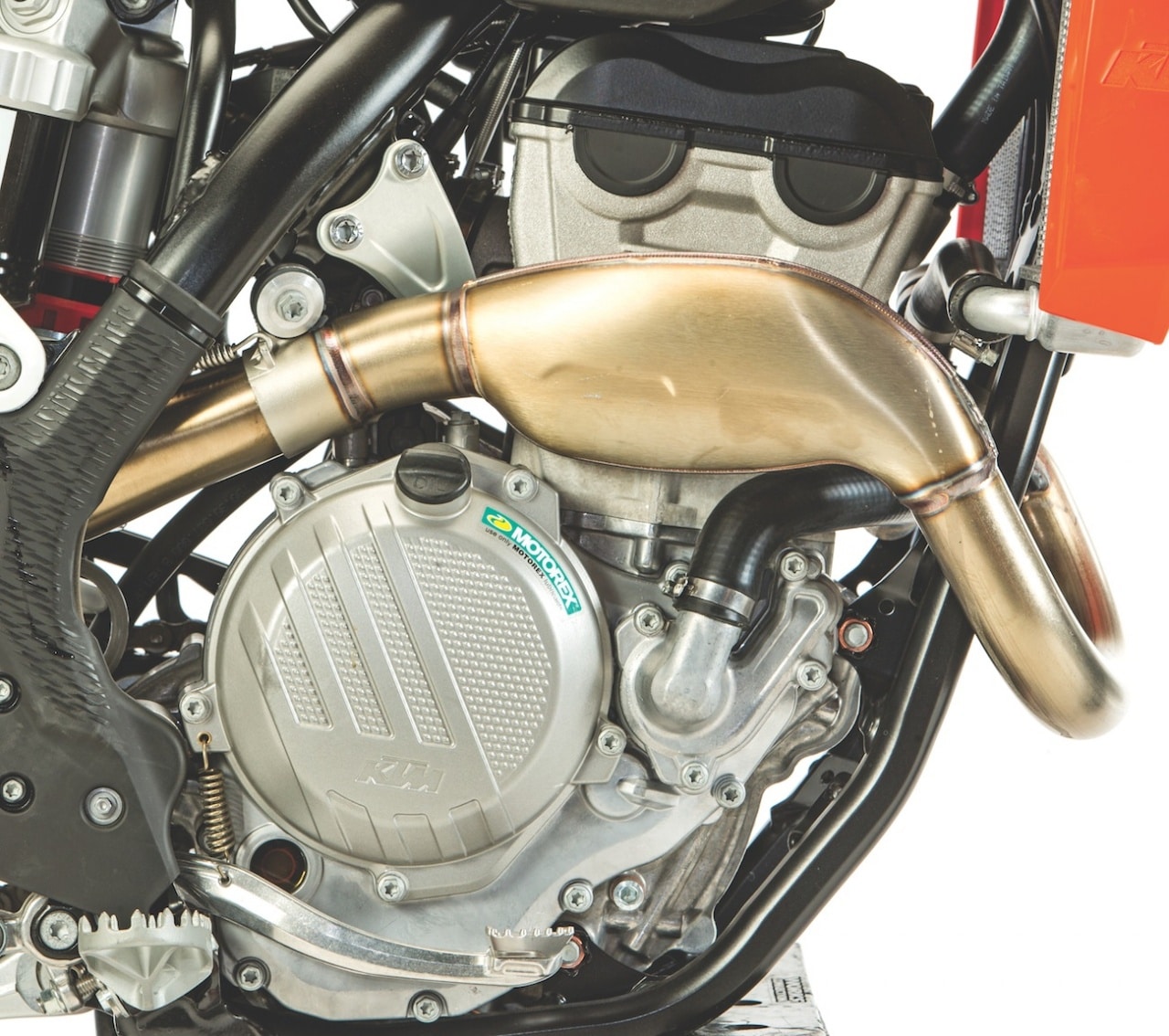
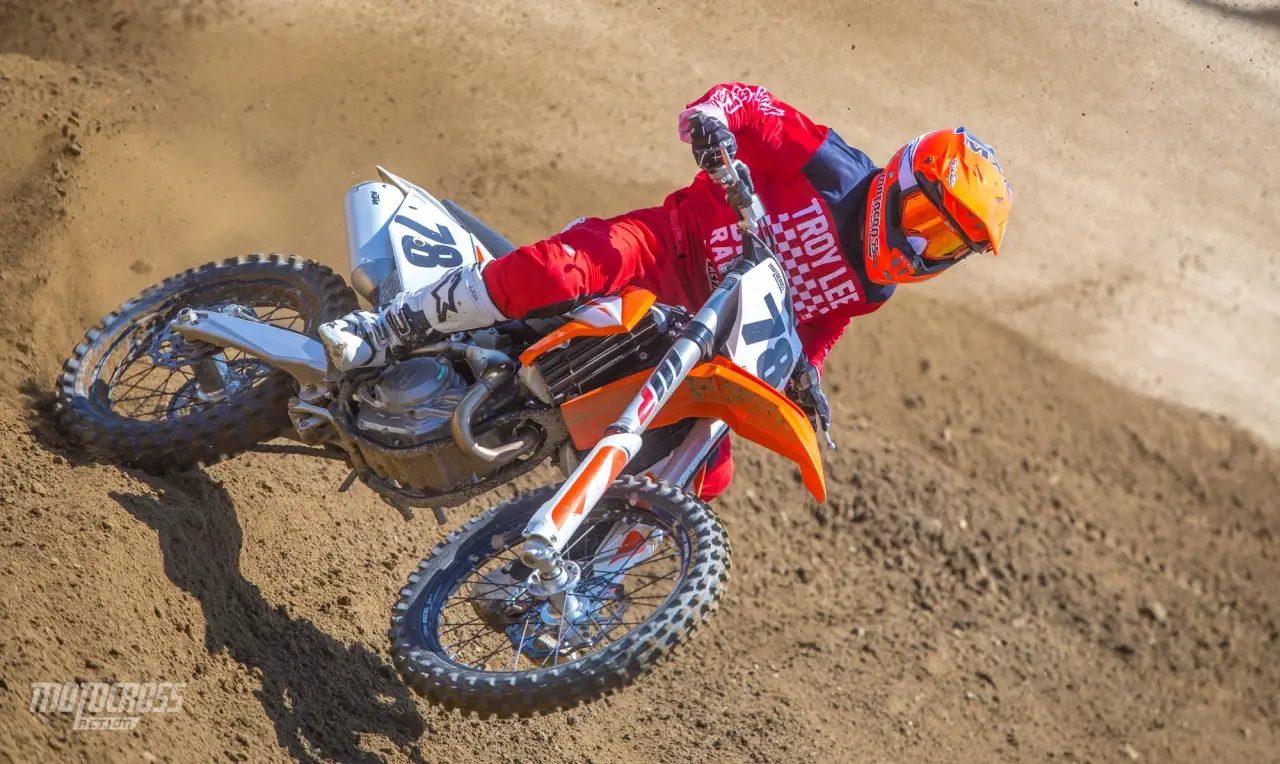

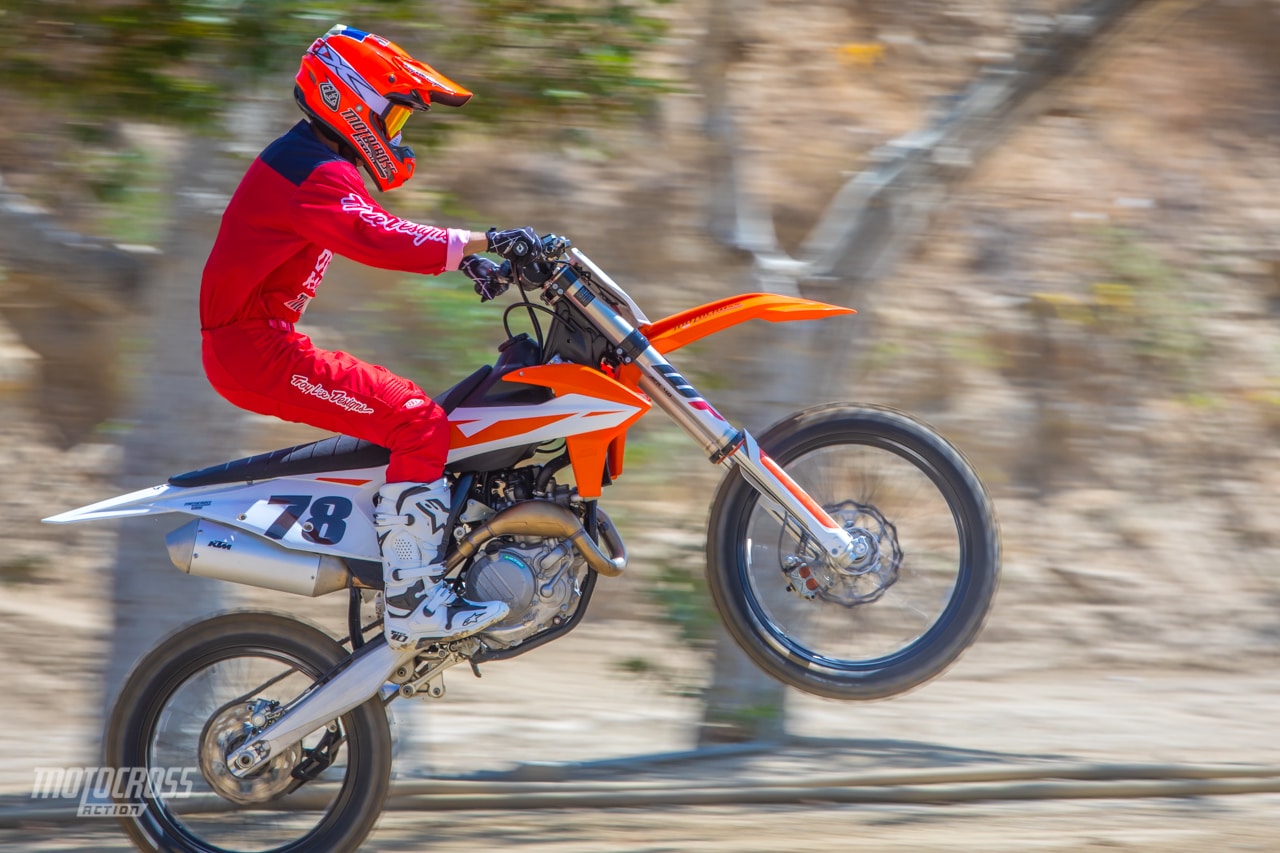

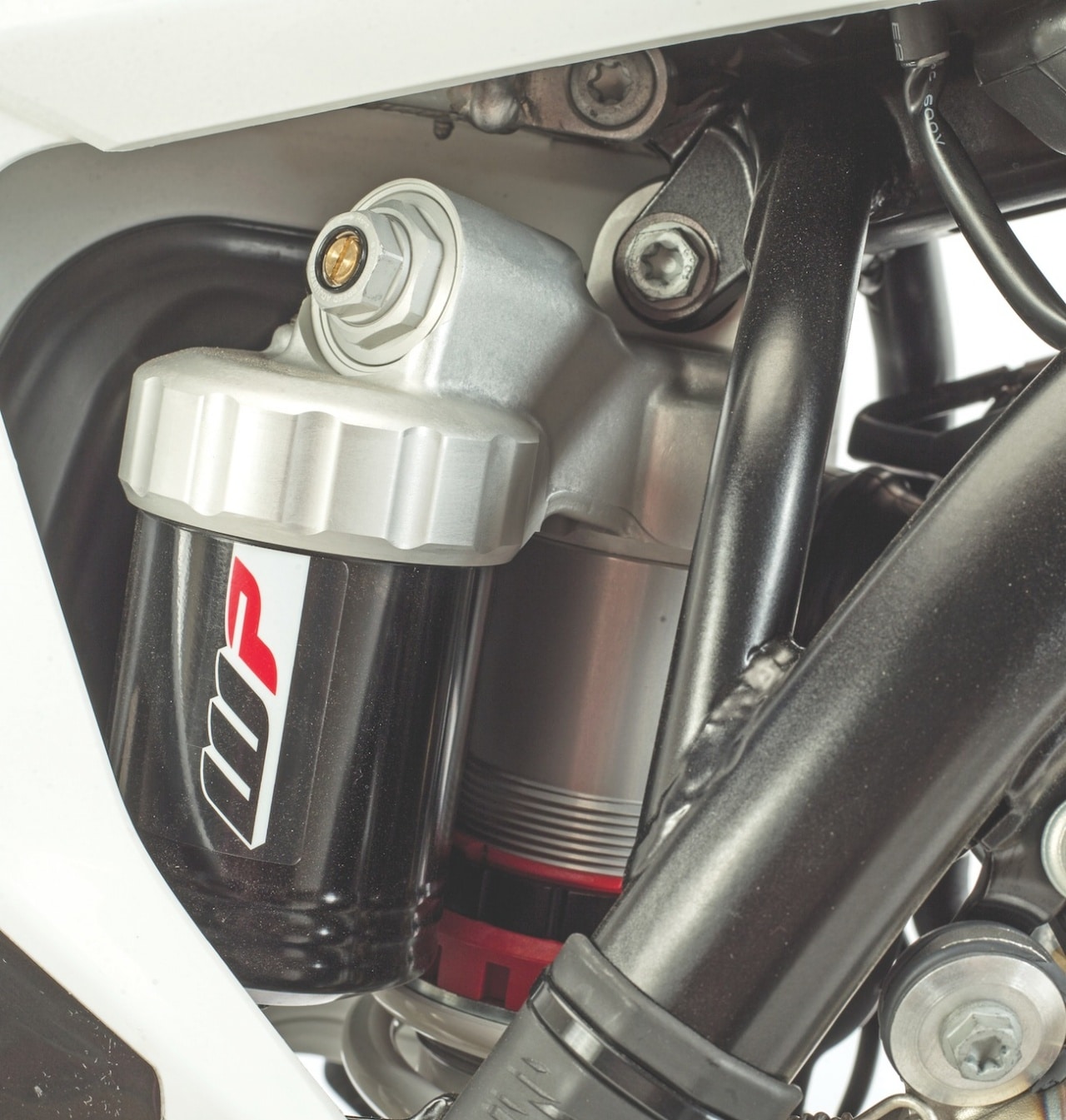


Comments are closed.